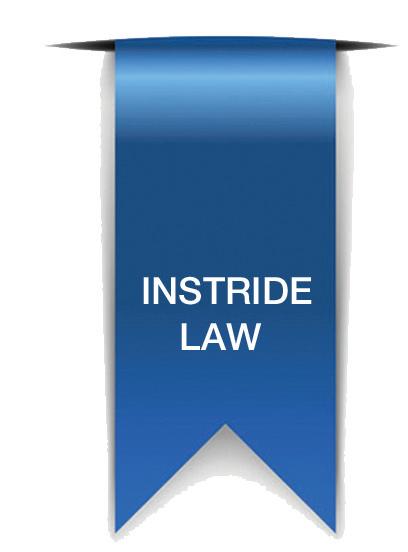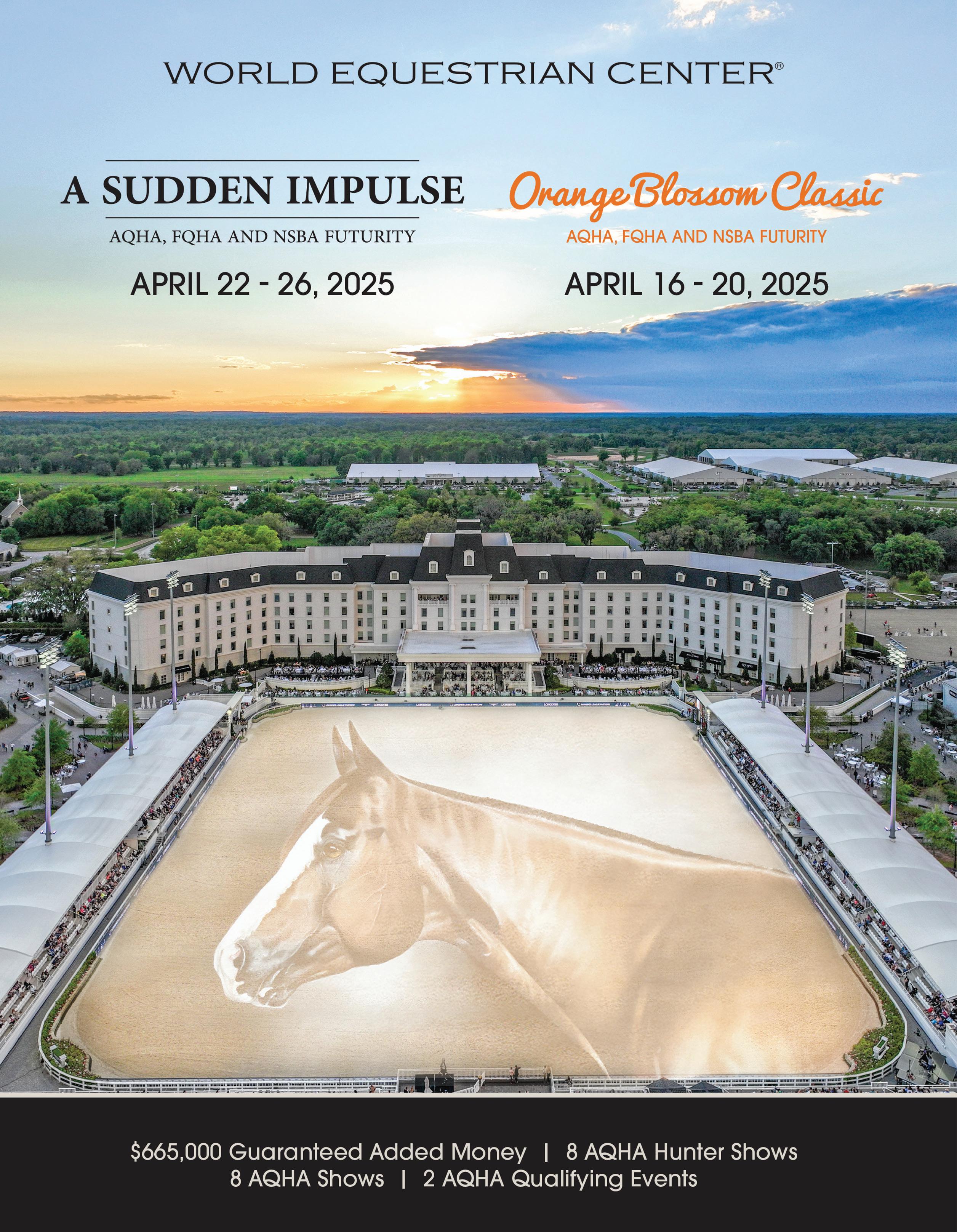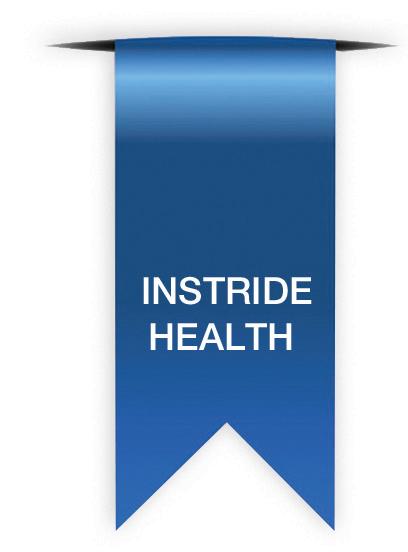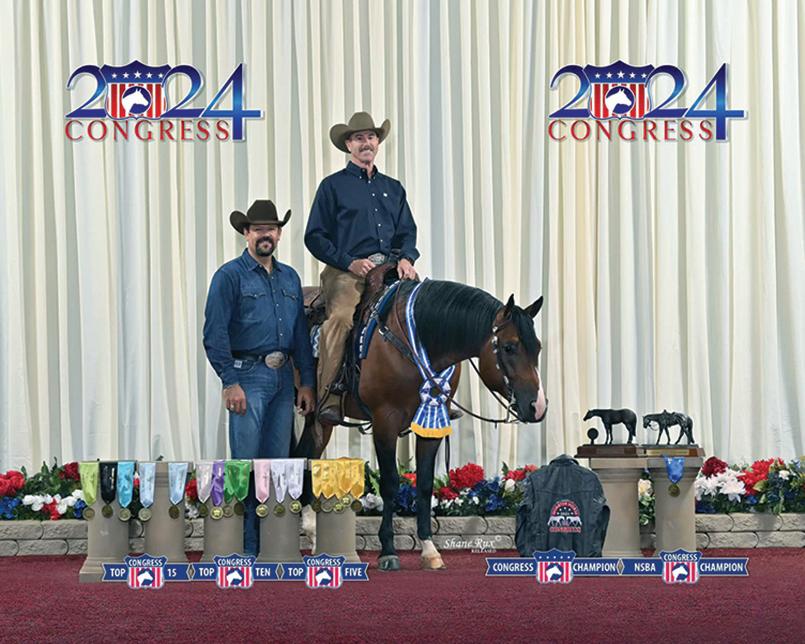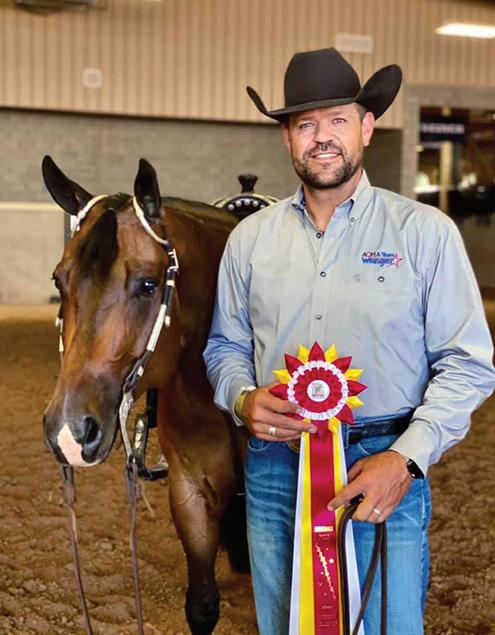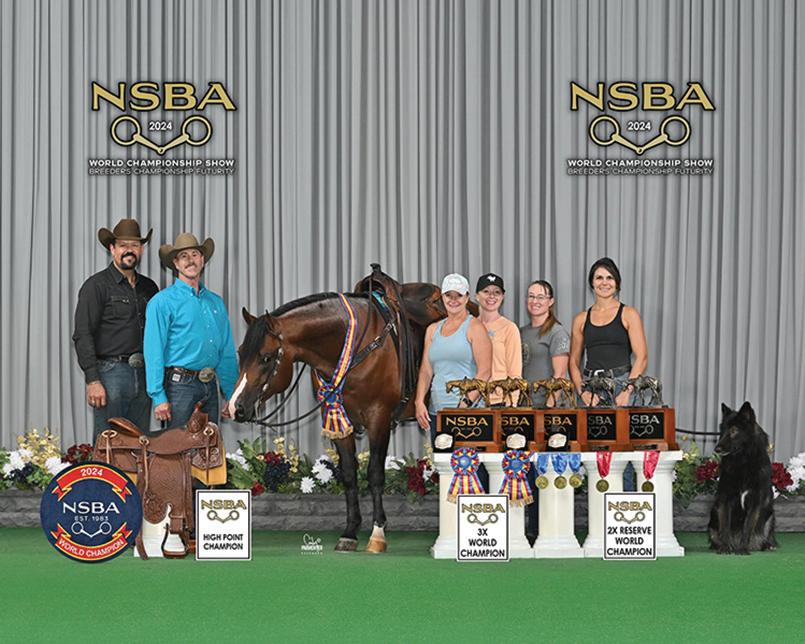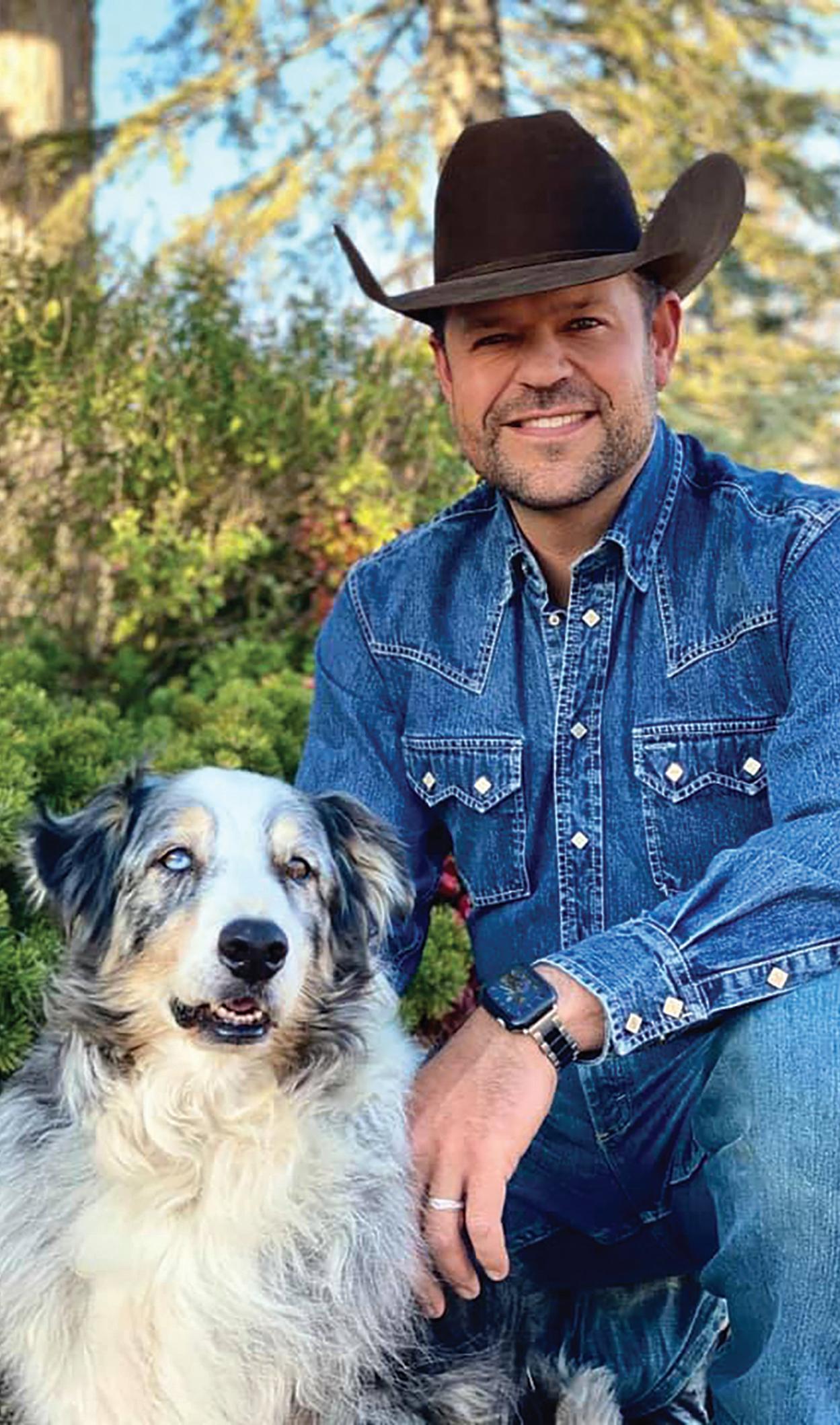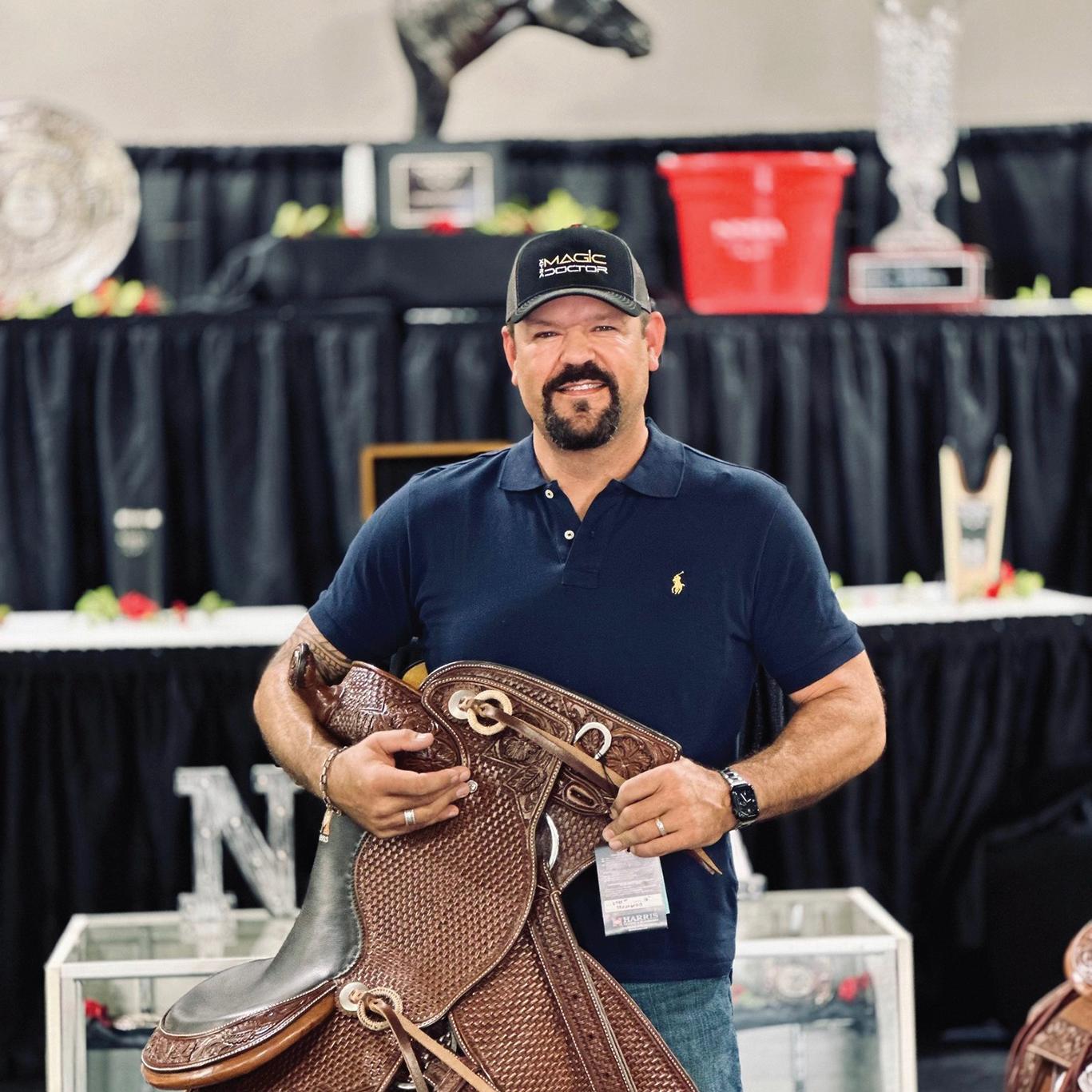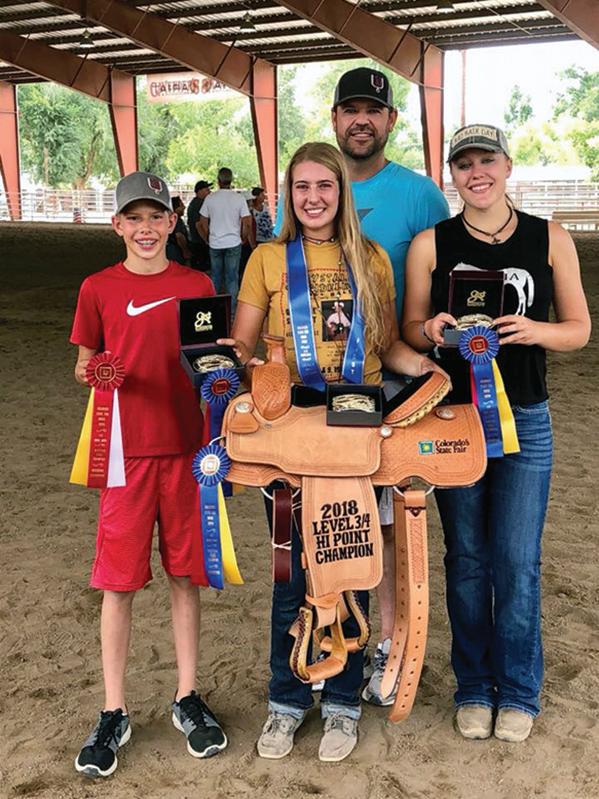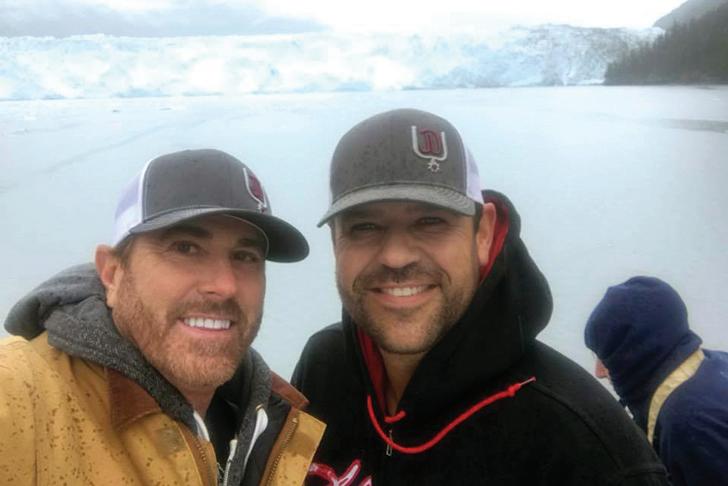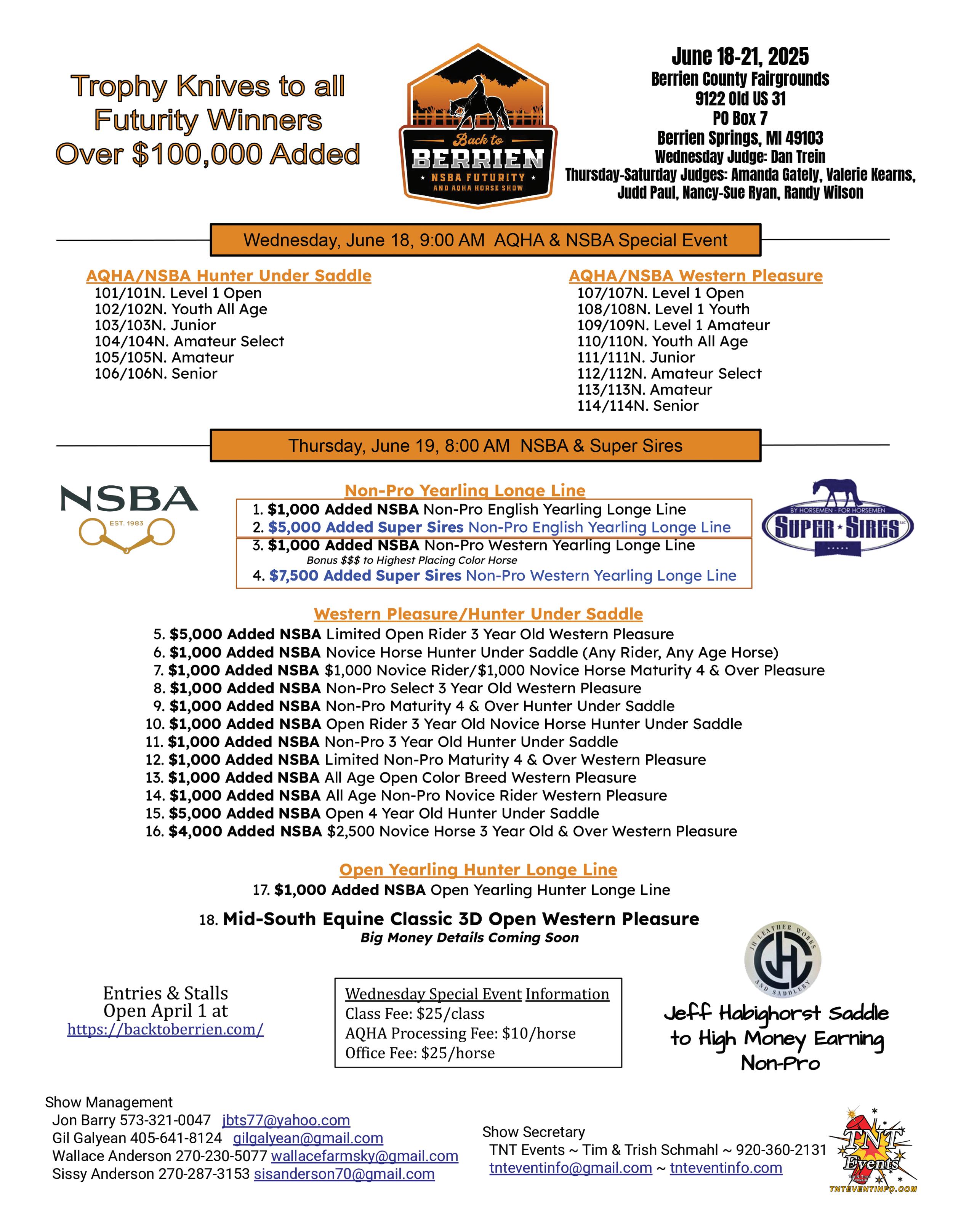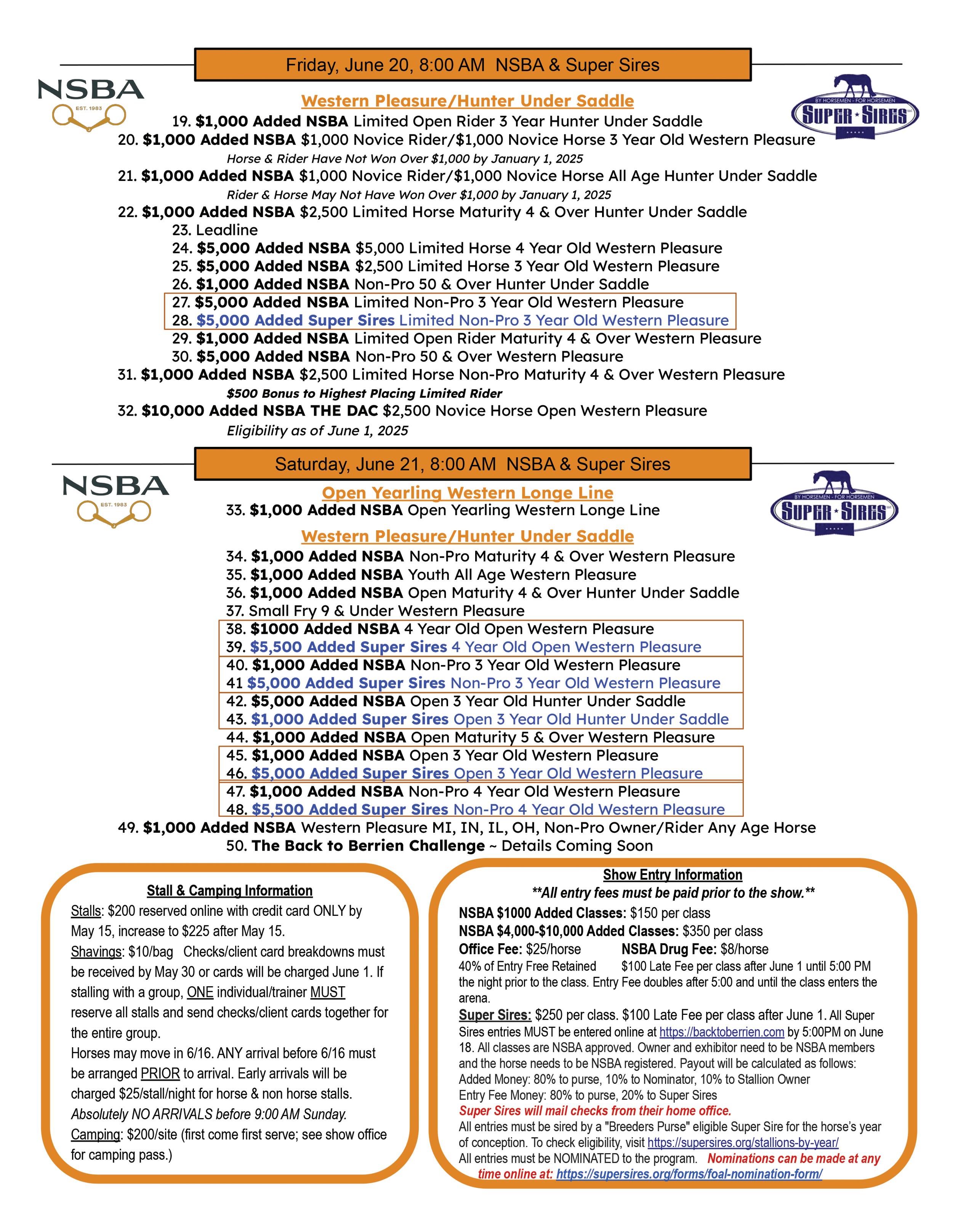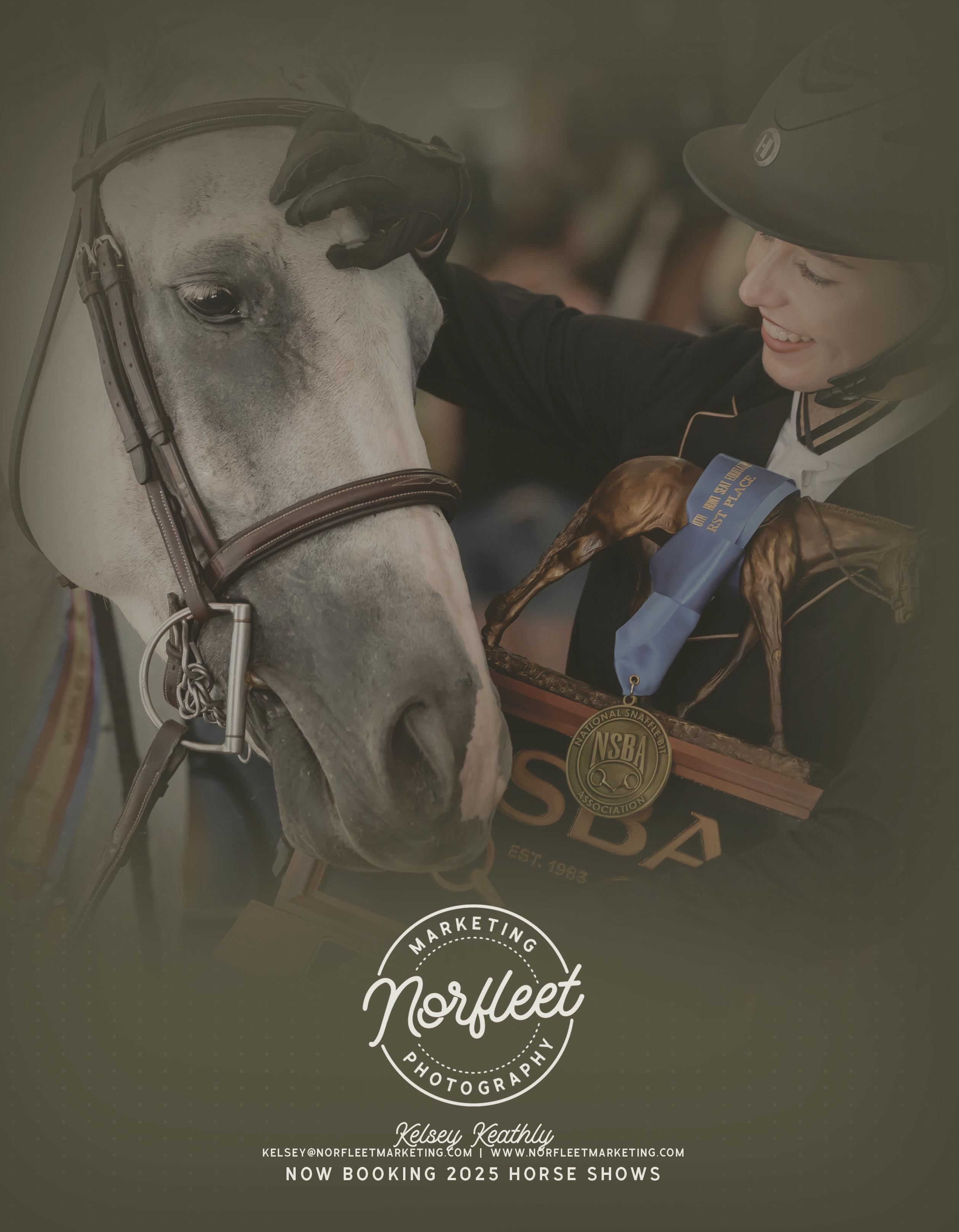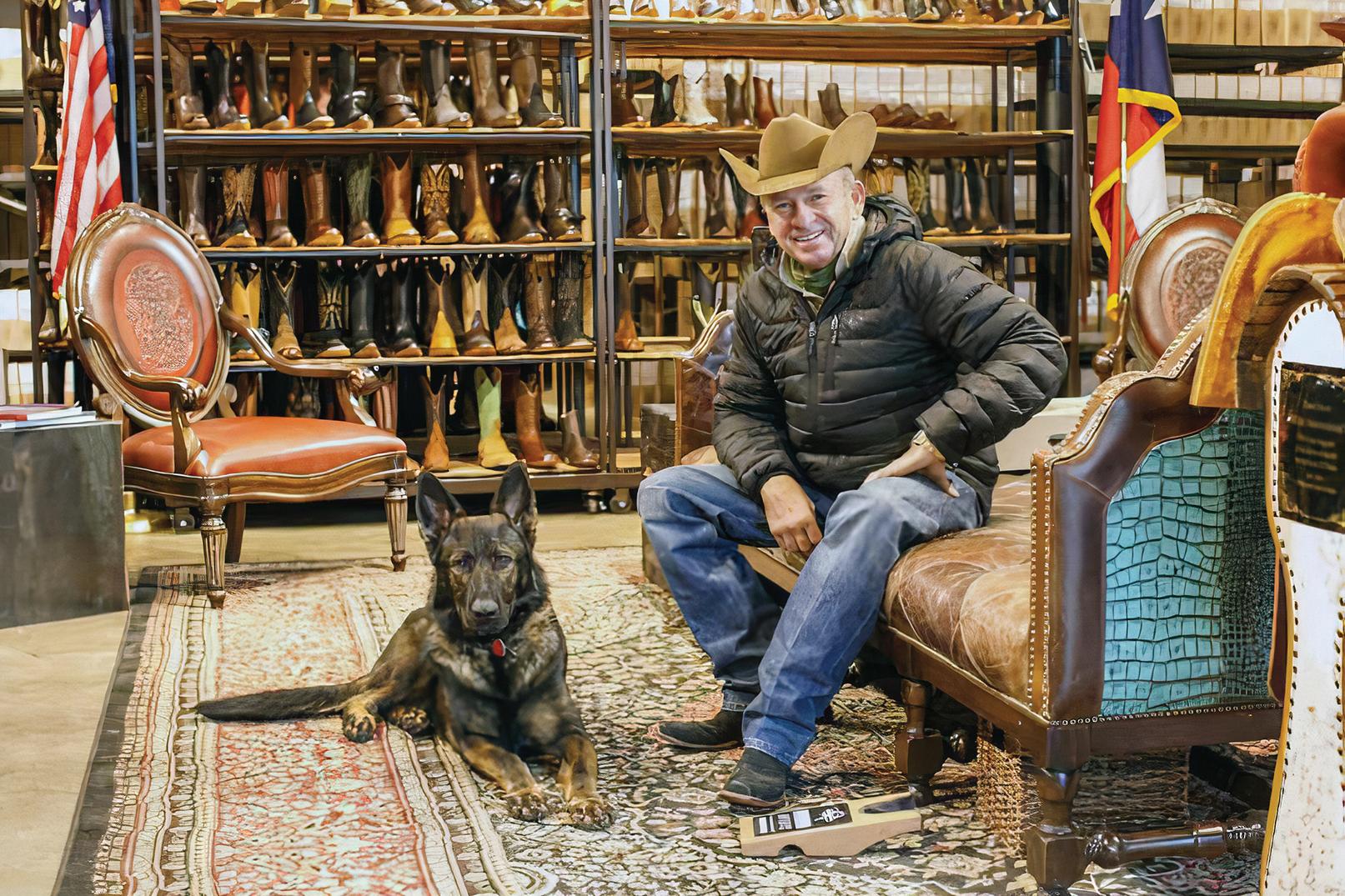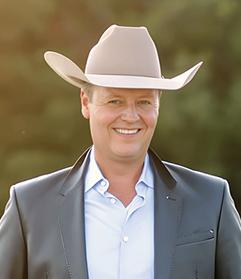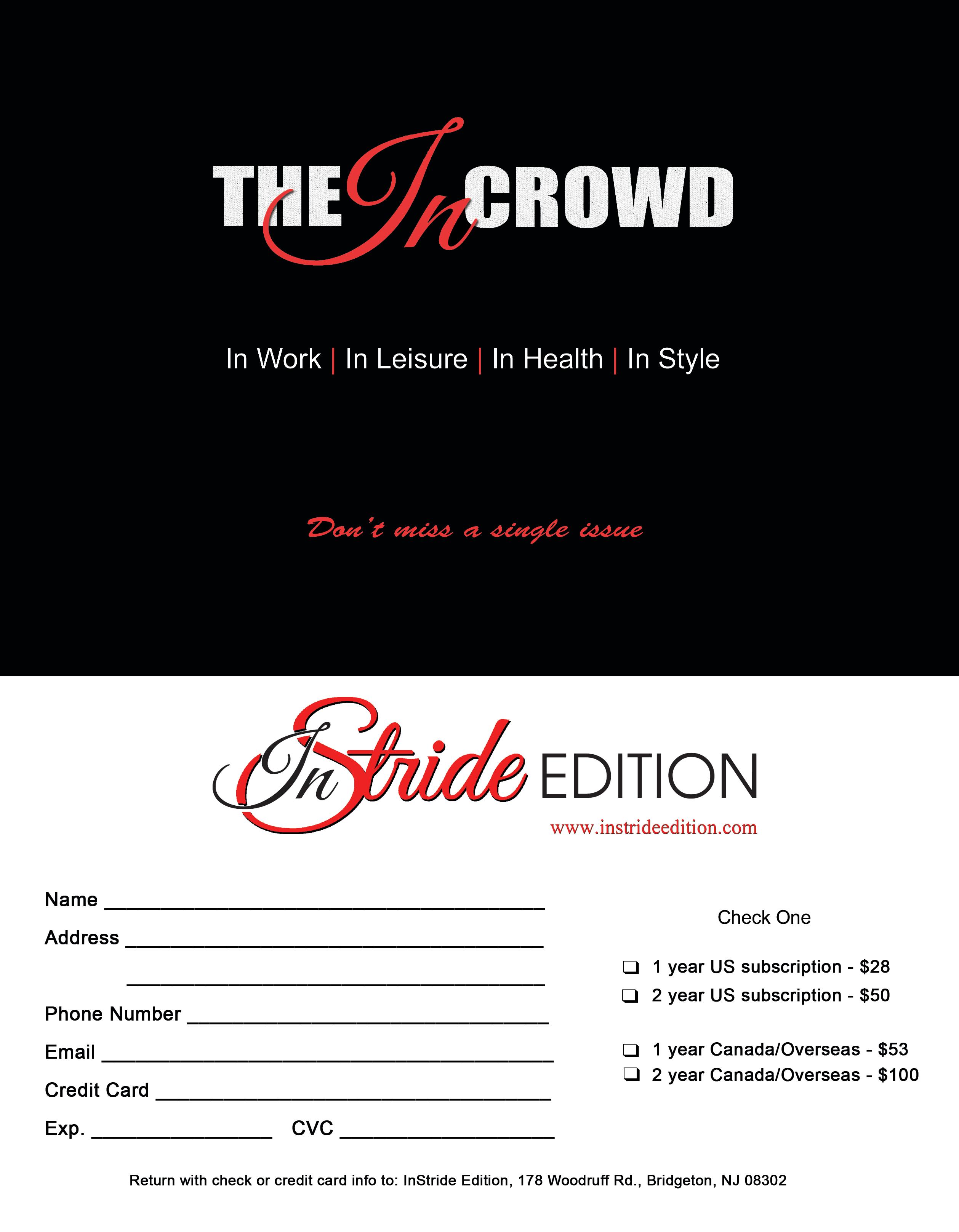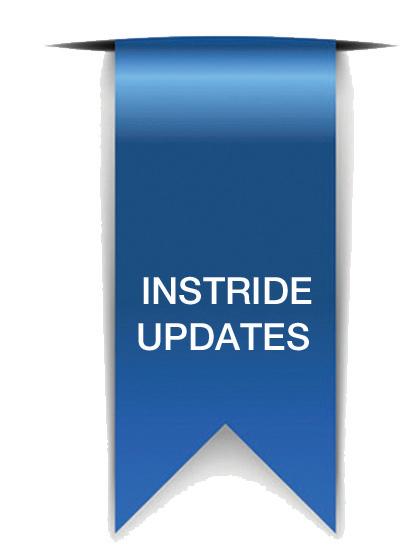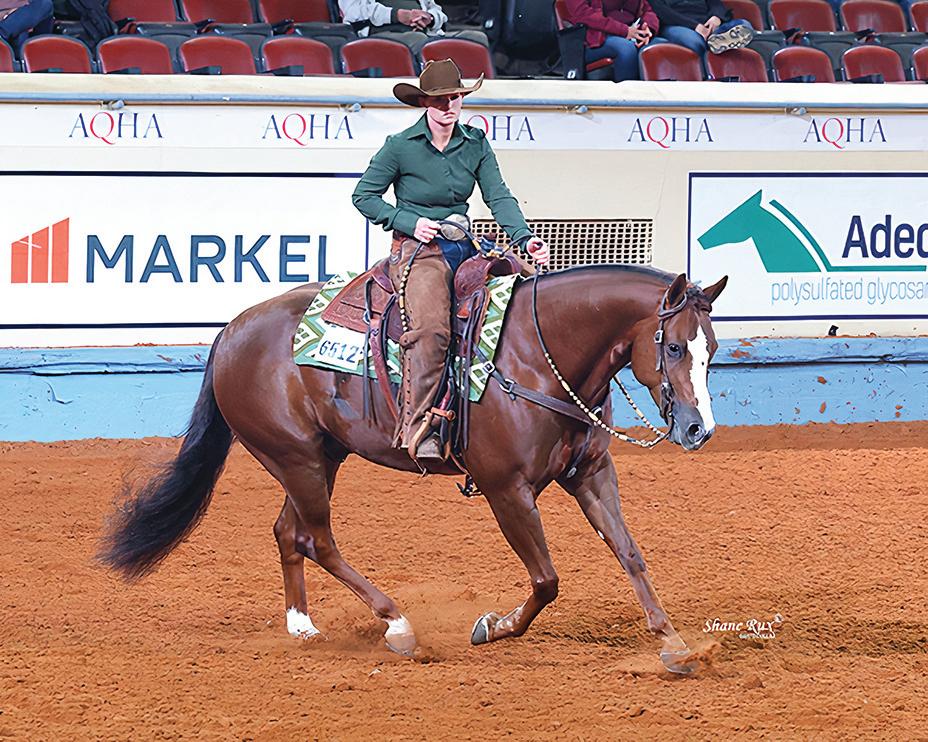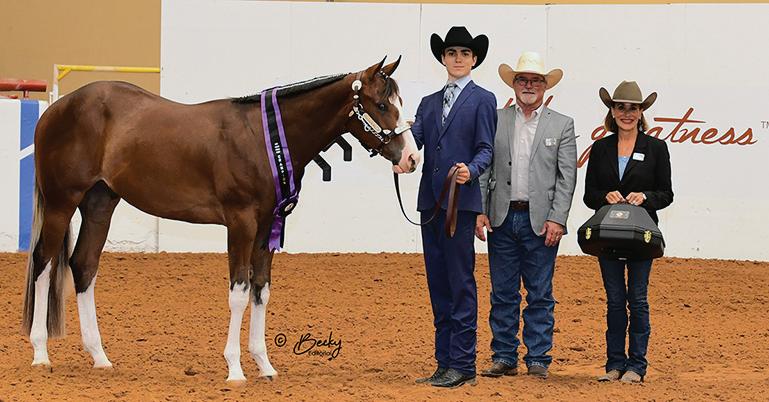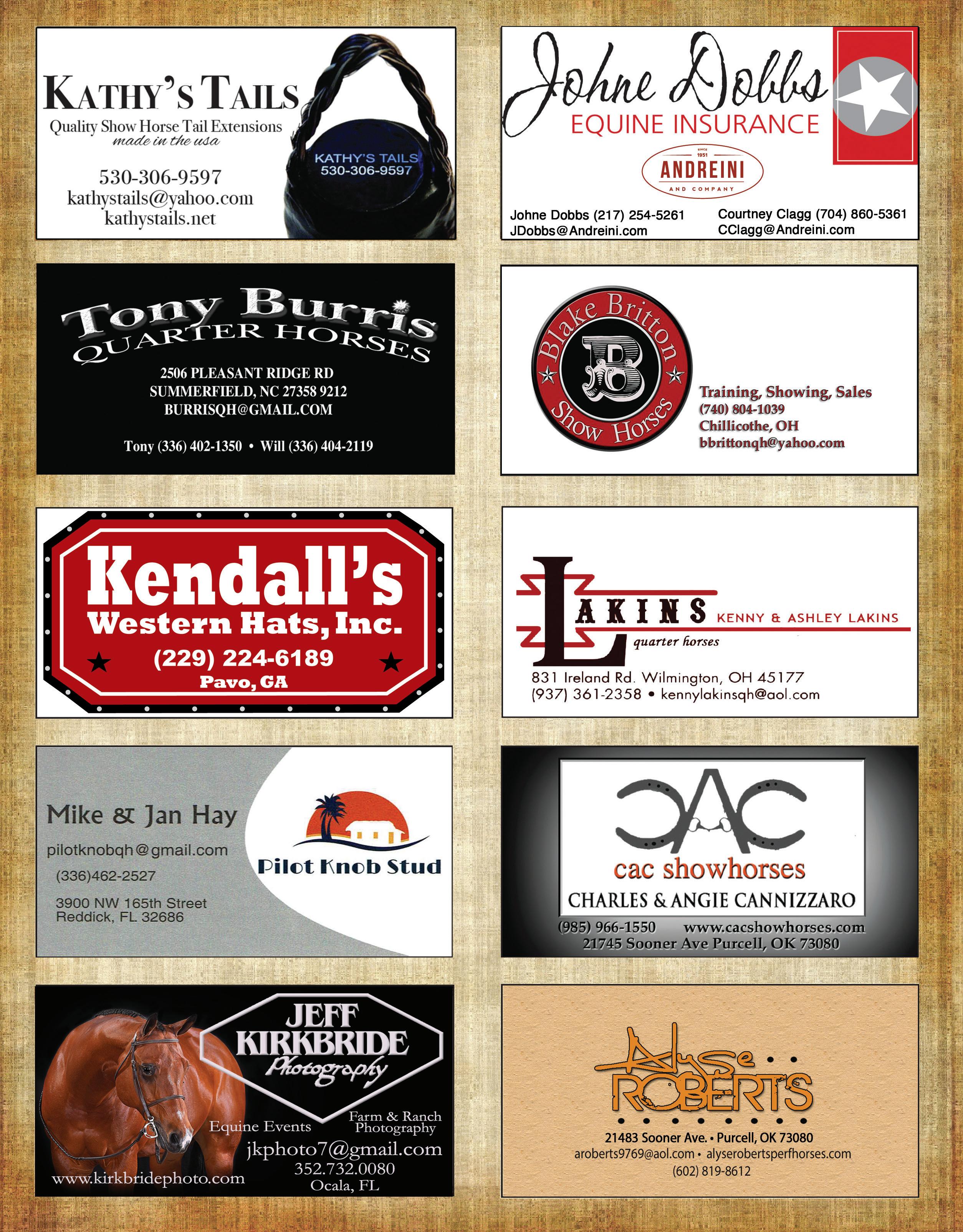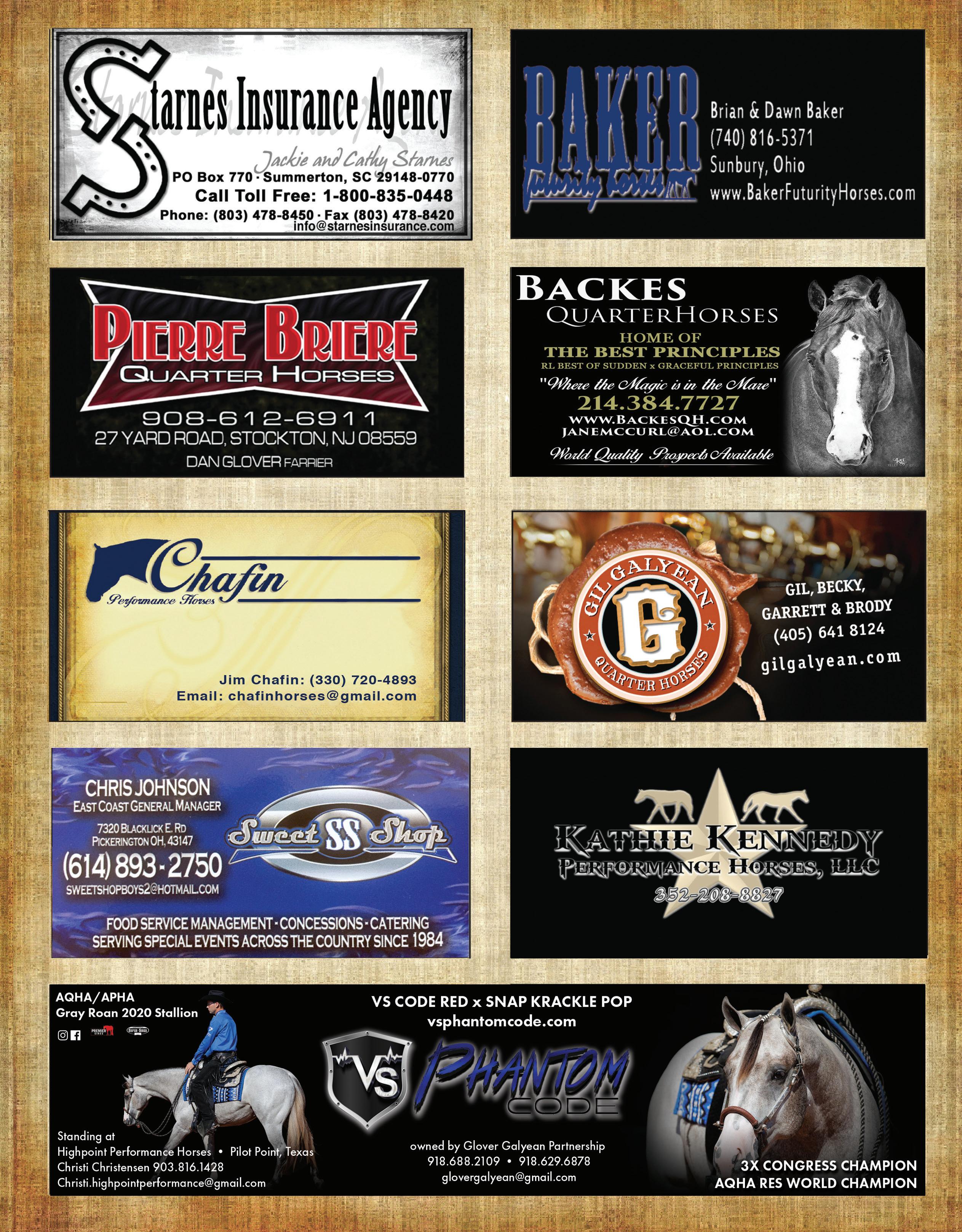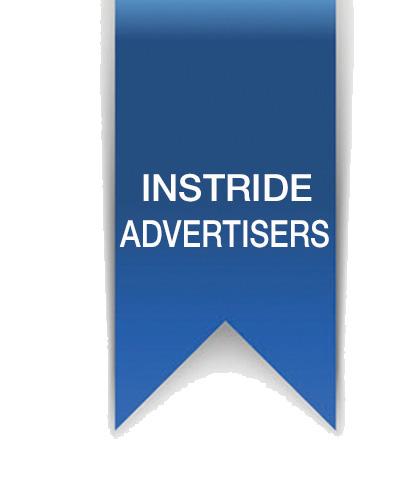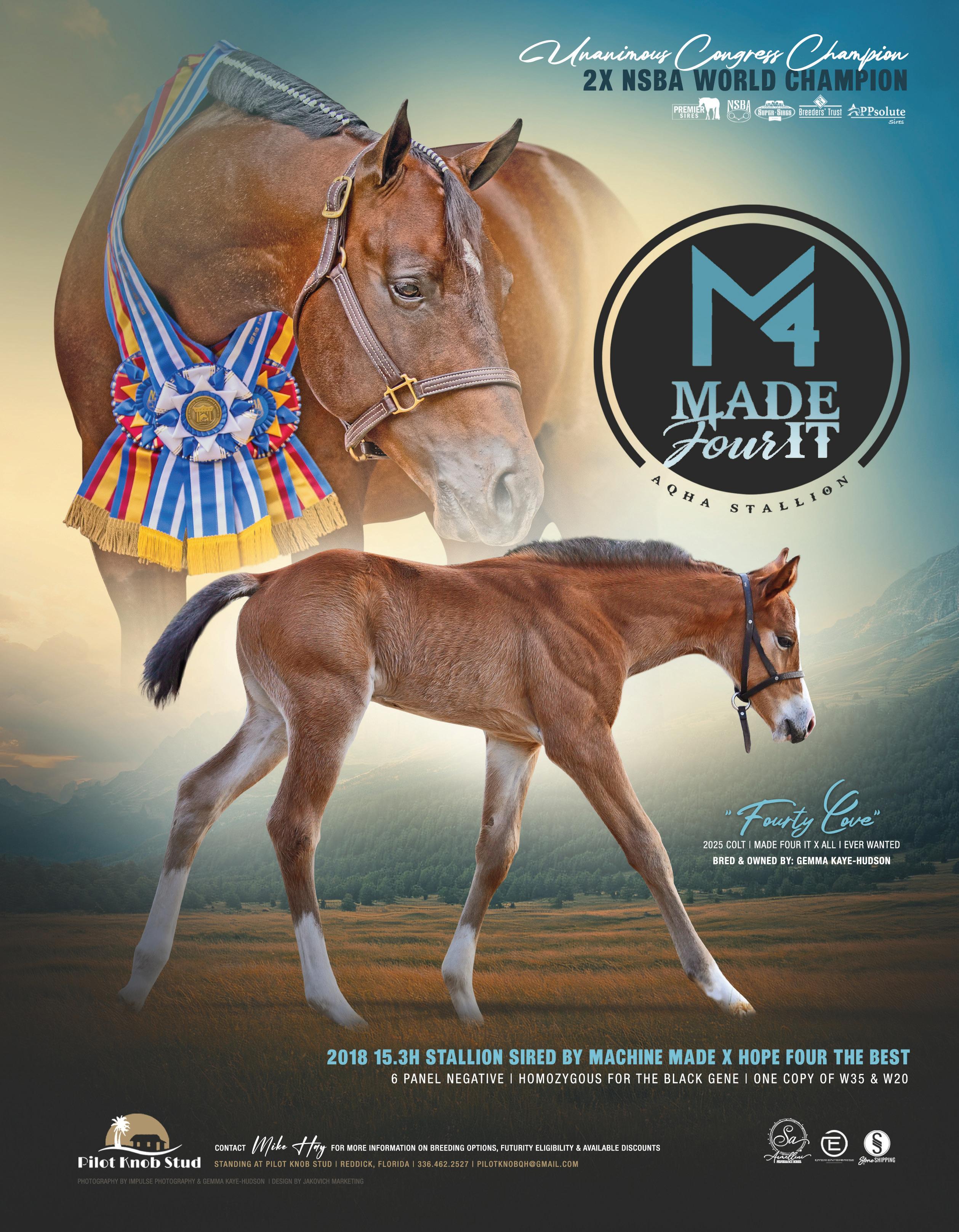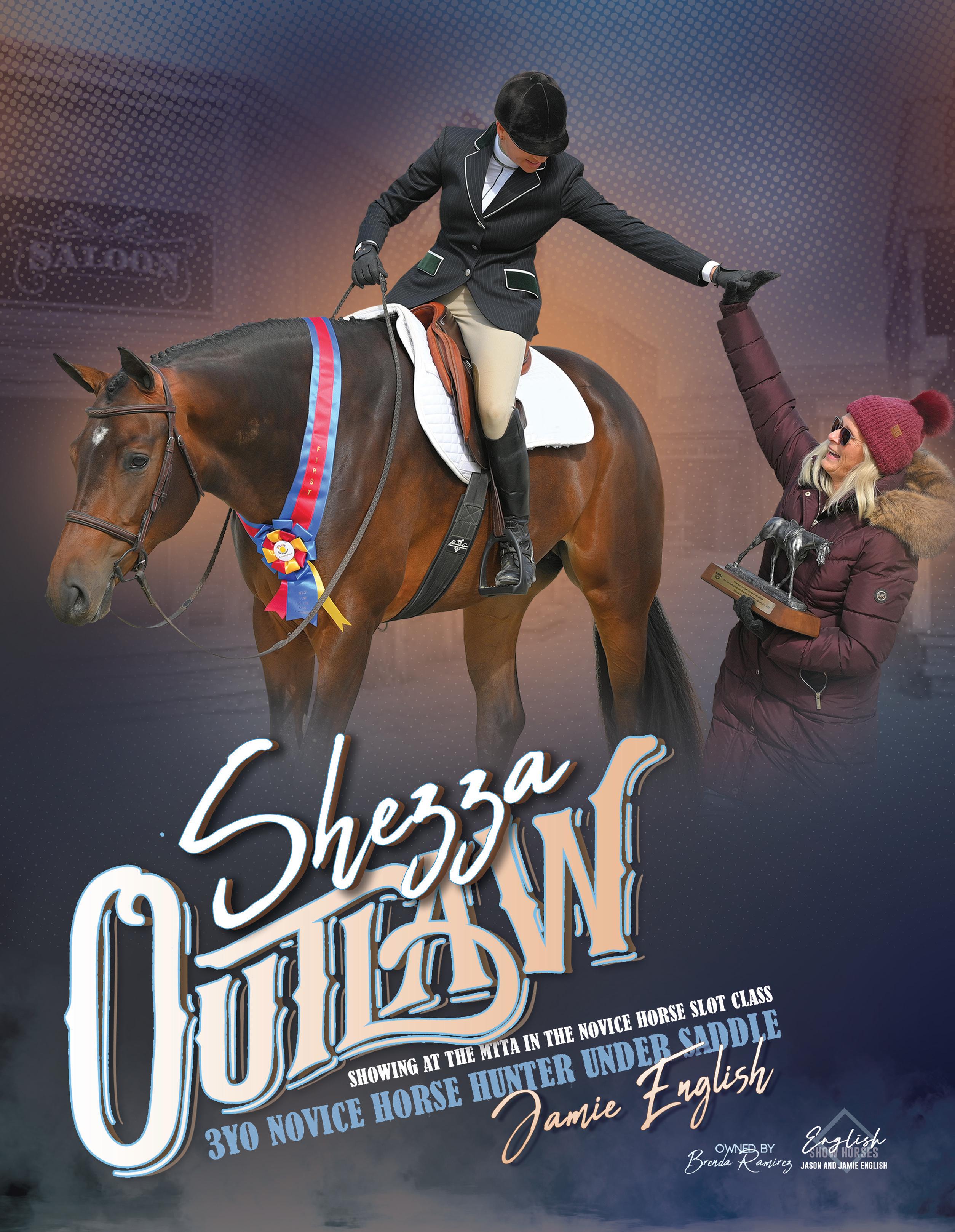


COVER STORY
HAY GOODLOOKN 10-13
By
Corrine
S. Borton
Photos by Superlative Equine & Shane Rux
FEATURES
SWEET SPOTS: DIYERS OFFER TIPS ON MAKING YOUR OWN HORSE TREATS 20-24
By
Corrine
S. Borton
Photos by Dreamscape Photography & Angela Wagner
EVENTS
JUST FOR SHOW: A LOOK AT THIS YEAR’S FUN IN THE SUN/FOX LEA FARM WINTER CIRCUIT IN VENICE, FLORIDA 32-34
By
Corrine
S. Borton
Photos by Jeff Kirkbride
CANDIDS
DIXIE NATIONALS 31
Cody Parmenter
PRAIRIE CLASSIC 36
Cody Parmenter
REGULAR COLUMNS
“INSIDE” LAW 37
By Katherine Jarve
“INSIDE” HEALTH 39
By Jordan Strickler
TRAINER PROFILE 40-41
Jimmy Daurio
ASSOCIATION NEWS 45 THE BUZZ 47

2025


ADVERTISING SALES
Courtney B. Ament
Deanna Green Willis
WEBSITE ADVERTISING
Courtney B. Ament
TECHNICAL ANALYST
Brent Adam Borton
CIRCULATION
Lenora B. Sheppard
SOCIAL MEDIA MANAGER
Kelsey Keathy
ADVERTISING DESIGNERS
Bar H Photography
Courtsey Designs
Emajes
Hampel Designs
Jakovich Marketing
Melissa Baus Designs
Norfleet Photography
SR Photography
Valor Designs
CONTRIBUTING WRITERS
Courtney Borton Ament
Corrine S. Borton
Katie Navarra
Brianna Huggins
COLUMNISTS
Katherine Jarve
Brian Burks
COPY & RESEARCH
Lenora B. Sheppard
CONTRIBUTING PHOTOGRAPHERS
Courtney Borton Ament
Dreamscape Photograhy
Jeff Kirkbride
Cody Parmenter
Ruehl Photographix
Shane Rux
Superlative Equine
Angela Wagner
Equi+Focus and Equi+Calm Pellets and Paste • Prices Vary • https://shopehi.com/collections/equine-performance-pastes


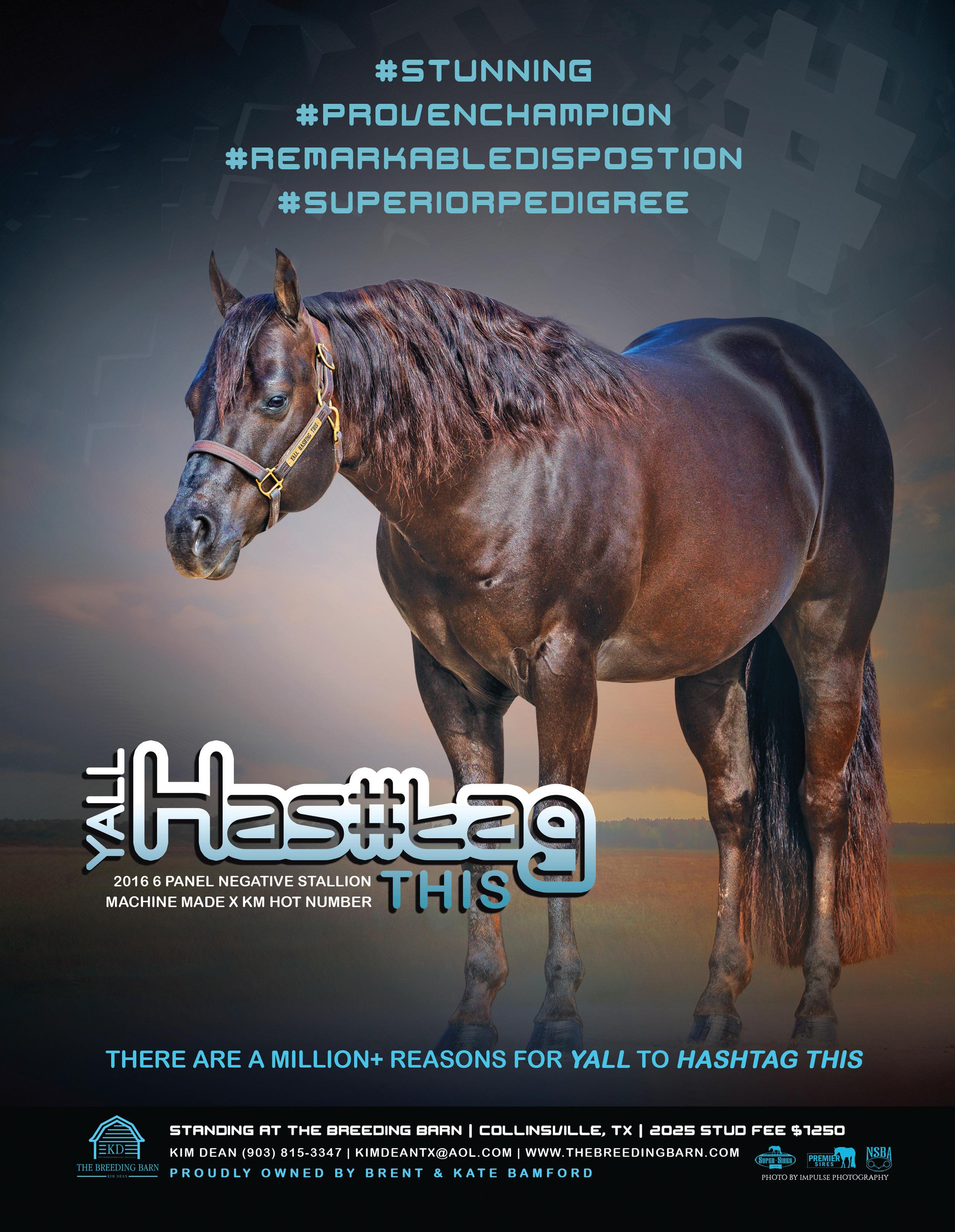

Text Corrine S. Borton Photos Superlative Equine, Shane Rux & Courtney B. Ament
It’s going to be tough to top the year Hay Goodlookn (Gus) foals had in the show pen in 2024 as his offspring recorded earnings well in excess of $250,000. But Blair and Susan Roberts and their daughter, Hillary Timchak, of Capital Quarter Horses, located in Pilot Point, Texas, are confident this is just the beginning.
The 2017 sorrel stallion by legendary American Quarter Horse Association (AQHA) performance horse sire Invitation Only and out of Whatscookngoodlookin (Candi), a multiple AQHA World and Congress Champion and National Snaffle Bit Association (NSBA) Horse of the Year was bred to be a show horse. And perhaps more importantly, he was bred to be a successful sire.
Hay Goodlookn’s first foals were only old enough to show under saddle in 2023 but already they are collecting accolades like AQHA World Champion, four Congress Champions, and Reserve NSBA World Champion.
Last year, Frank The Tankk, out of All Kinds

of Trouble won the Coughlin 2-Year-Old Open Western Pleasure at the Quarter Horse Congress with Katy Jo Zuidema in the saddle. The win marked the second straight year the 2022 palomino gelding won a Congress Championship. In 2023 he and Kathie Kennedy won the Open Western Longe Line.
Up To Know Good was the 2023 AQHA World Champion in the 2-Year-Old Open Western Pleasure and in 2024 she and Hillary Timchak won a Congress Championship in the 3-Year-Old Non-Pro Western Pleasure and she placed fourth in the 3-YearOld Open Western Pleasure with RJ King.
City Limit Signs, a 2021 red roan gelding out of No Doubt Im Lucys, owned by Starland Ranch and shown by Aaron Moses, won the Novice Horse Western Pleasure and Green Western Pleasure at The Premier last year and was the Green Western Pleasure s
Champion at the Sudden Impulse Futurity.
Hay Girl Hayy, a 2021 sorrel mare out of Johnnie On The Spot, was bred by Capital Quarter Horses. Hay Girl Hayy and RJ King won the $100,000 Maiden Open Western Pleasure at The Sudden Impulse Futurity last year and Timchak rode her to a win in the Non-Pro Novice Horse Western Pleasure at The Premier. Jordan Macan, of Kearney, Missouri, purchased Hay Girl Hayy in July and went on to win the Super Sires 3-Year-Old Limited Non-Pro Western Pleasure at the Congress, while Blair Thownsend earned a Congress Championship on the mare in the Congress 3-Year-Old Limited Open Western Pleasure.
Forever In Always, a 2022 bay mare out of Forever Kool, bred by Ditty Up Quarter Horses, Ocala, Florida, was Reserve World Champion in the 2-Year-Old Level 3 Open Western Pleasure at the AQHA World Show with Cole Baker.
Feeling Groovey, a 2022 sorrel mare out of Forever N Ever, was bred by Stanley Scott, of Reddick, Florida. With Casey Willis in the saddle, Feeling Groovey placed third in the 2-Year-Old Level 3 Open Western Pleasure at the AQHA World Show last year.
Look Here Cowboy, a 2021 red roan mare out of Huntin For A Cowboy, was bred by Stanley Scott, of Reddick, Florida and is now owned by Jessica Landry, of Titusville, Florida. She has logged numerous big futurity wins with Landry in non-pro classes.
Timchak says the thing she has noticed about the Hay Goodlookn foals is that they are all so trainable and so good minded.
“Every bloodline we’ve crossed him on has played to both his and the individual mare’s strengths, and made a solid, strong, show horse,” she explained.
And numerous trainers agree.
“The Hay Goodlookn babies we have had in our program have all been very naturally talented,” said








Florida trainer Cole Baker. “They jog well and lope very true and natural. They have great eye appeal and good size, very suitable to go onto the all around as well. Whatscookngoodlookin’s influence is very apparent in them especially the fillies. We have liked all of them we have had and have enjoyed great success in the show arena. Gus is a go to for us for breeding.”
Katy Jo Zuidema, a Florida trainer who started and showed Frank The Tankk, said he is just “the best.”
“He’s a true jogger and he has so much self-carriage and rhythm,” she explained. “Anyone can ride him. He loves to show. His ears are always forward and I trust him. I think he’s gonna be a great Western Rider too.”

Timchak said it is important to her that not just the trainers, but the nonpro owners are also having success riding Gus offspring.
“To me that’s a huge deal,” she said. “For our industry to continue to thrive, non-pros have to enjoy and be confident showing young horses. The more this happens, the more people will breed and purchase horses intended to show in the futurity business. If Hay Goodlookn can help contribute to keeping that market strong, I feel we’ve done our job”
In addition to watching and keeping track of Gus offspring raised by customers, Capital Quarter Horses is excited about youngsters sired by Gus out of such decorated mares as Aint Nothn To It, Momma Knows Best, Johnnie On The Spot, Shez Immortal, Flashy Looking Lady, and more.
“We usually foal out 10-15 a year, keeping a few for ourselves to send to training and offering a few to the public for sale,” Timchak explained.
In 2025 Capital Quarter Horses plans to expand sale offerings and select a few more for the public’s consideration.
“If you’re looking, we have it,” Timchak said. “Please contact us to come look at some of the best bloodlines in the business. From weanlings and yearlings to 2-year-olds, located at CAC in Purcell, Oklahoma or King Show Horses, in Pilot Point, Texas. We love to see our prospects continue on with other programs and be successful.”
Those foals born at Capital Quarter Horses get their start right there on the farm, under the supervision of
Greg Johnson, facility manager and trainer. Once they’re ready for the next step, they are sent out to Angie Cannizzaro, of CAC Show Horses; RJ King and Blair Townsend, of King Show Horses; and now, Reining prospects go to Kole and Kelsey Price, of Price Performance Horses.

“We will see where their training process takes them, but they all look to have very bright futures,” Timchak said.
Hillary and her mother, Susan Roberts will also return to the show pen later this year riding Gus offspring raised by Capital Quarter Horses.
“This year is a bit transitional for me as my husband, Eric, and I recently welcomed our daughter, Lena Elisabeth, to our family,” Timchak said. “However, when it’s showtime again, my mom, RJ King, and I will be showing Up To Know Good in the maturity events. I also have a fantastic 4-year-old mare with Angie Cannizzaro that’s by Gus out of the great producing mare Ima Potential. She showed last year at the Premier and was Reserve in the Novice Horse Open Western Pleasure with Angie (Cannizzaro). We are excited to break her back out and show her off. She’s amazing.”
Hay Goodlookn stands right there at Capital Quarter Horses. His 2025 stud fee is once again $3,500. The booking fee of $500 is included in the total stud fee. Shipping via UPS/Fedex is $325 while counter to counter is $425. Local pickup is $125. Gus foals are eligible for all the major programs: NSBA BCF/Color BCF and SIF; APHA Breeders Trust; Premier Sires and Super Sires; SBB, West Coast Breeders, as well as Iowa and Michigan Breeders Futurity. Discounts are offered to proven mares.
“Our breeding program is the integral piece of what we do. Breeding Manager Leslie Bailey and Assistant Ashley Wong do a great job with Gus, as well as new reining stallion Golden Coins and Appaloosa stallion That’ll Do, owned by Trish Doyle,” Timchak said.
This will be an exciting year for Capital Quarter Horses. In addition to adding a new baby to the family, welcoming new Gus foals into the world and returning to the show pen, a new facility us being built situated on 123 acres off Highway 455 and Merrill Road in Pilot Point. It will include a four-stall stallion barn, six-stall foaling barn, as well as a show barn, breeding barn and offices similar to those in the current location.
But Timchak says it’s the team that makes Capital Quarter Horses so successful.
“Every person that works with us has the best interest of our program at heart,” she said. “I think the level of quality and perfection we strive for is only attainable if the people on the team have the same ideals, goals, and expectations. Everyone comes to work to give 100% every day, and that’s what you have to have to run a successful business.”
For additional iformation all Capital Quarter Horses at (940) 324-5952.









As a Pre-K to 5th level STEM (Science, Technology, Engineering and Mathematics) teacher at Horry County Schools in Conway, South Carolina, Christine Smith McClure is always looking for a way to show her students how to engineer a fix for problems that arise daily. It’s key to providing them with critical thinking and problem-solving skills. As a lifelong horse lover, however, she never hesitates to incorporate them into her lessons.
In March of 2020 McClure got the opportunity to teach an online course to second graders and it was around that same time she came up with Cowgirl Country Cooking with Christine, a Facebook page where she shares recipes and food tips for “hungry cowgirls and cowboys.”
“One of my friends had mentioned she was making treats for her dogs and was thinking of marketing them to sell,” McClure explained. “From that, the idea was born that I could make horse treats. Afterall, my horses love treats.”
Christine and her husband, Steven, have three registered Quarter Horses (FQH Blue Delux, Bueno Draggo and DHF Hickory Rose) and three American Miniature Horses (Sadie, Daily and Duke) at their Dreams Hope & Faith Ranch in Conway.
But McClure didn’t stop there.
“I thought, I could make my horse treats while teaching class online and then, as a way to reward good behavior from students, I could take the camera out with me to feed the treats to the horses,” she said.
Seemed like a winning strategy. The horses get treats and the students are all ears during class, excited to be able to see the horses devour the treats.
When she started discussing the idea of making horse treats with her friend, much of the conversation centered around cost ratios of making treats vs. buying them, and of course, how they could be made with maximum health benefits.
“My recipe was made up of ingredients I already had, starting with apples,”McClure said. “This teacher gets plenty of apples from her students. They always save them from lunch and bring them to me. This turns into a math lesson of we have x number of horses and if we want them all to have equal amounts of apples how should we divvy them up? Pumpkin puree is a key ingredient it adds flavor. Molasses helps the mixture stick together I like to use quick cooking oats, brown sugar, carrots and sometimes cranberries. If I have a little flax



seed I throw that in as well. I measure from the heart so the exact recipe varies with each batch.”
McClure uses a large bowl to mix everything together and then scoops out the mixture in 1 tablespoon portions and rolls each into a ball and spreads them out on a baking sheet.
“They can be placed very close to each other on the pan because they do not rise or spread,” she said. “I can usually get about five dozen treats per batch.”
McClure says the hardest part about making horse treats is deciding what to put into them. She likes to play with the
ttt
Christine Smith McClure, pictured on this page, has been making her own horse treats since 2020. In addition to providing her own horses with tasty and healthy snacks, she uses the process as a learning tool for her own students. First she assembles the ingredieants and mixes them together. Then she forms them into small balls and places them on a cookie sheet. Each batch is baked for 8-10 minutes. On the opposite page (top) Angela Hughes, makes her own birthday cakes for her horses.
recipe to add different ingredients to change up the taste.
“Once you have decided on which ingredients to use, you can turn out a batch in about 25-30 minutes,” she explained. “I usually bake them for about 8-10 minutes. You can bake for less time for a softer treat. Longer for a more traditional horse treat.”
ALTERnATIVE TREATS
Talk to any horse owner, and you are likely to hear of some weird food they have given their horse as a treat. This could range from gummy candies, cake, or even beer. Remember that treats should be given in small amounts and not be a main component of your horse's diet. In addition, many processed human food items, such as candy and cookies, contain high levels of sugar and starch. If you have a horse with metabolic issues (such as laminitis), you may want to avoid these treats. Ultimately, remember that feeding in moderation is key.
The Penn State Extension Service lists the following as acceptable and unacceptable food treats for horses. Note this is not a complete list; always talk with your veterinarian or equine nutritionist if you are unsure of feeding something to your horse.
ACCEPTABLE HORSE TREATS
• Apples – This is a safe treat. Cut the apple into slices so your horse will not choke.
• Carrots – This is a safe treat. If a large carrot, break into smaller pieces before giving it to your horse.
• Peaches – This is a safe treat. Before giving to your horse, take out the pit in the center. Just like apples, slice the peach into smaller pieces to ensure that your horse does not choke.

Broccoli may cause an excess buildup of gas in the hindgut. Tomatoes – Stay away from giving this to your horse. Tomatoes are a part of the nightshade family, which are toxic to horses.


• Bananas – This is a safe treat. Break the banana into small chunks to ensure that your horse does not choke.
• Cucumber – This is a safe treat. Break the cucumber into small pieces to ensure your horse does not choke.
• Peppermints – This is a safe treat. Keep peppermints in moderation.
• Sugar cubes – This is a safe treat. Keep the amount given in moderation.
• Commercial treats – This is a safe treat. Follow feed directions on label.
POTEnTIALLY ACCEPTABLE HORSE TREATS
• Animal Crackers – These are high in sugars and/or starches, don't give in excessive amounts, and potentially avoid for horses/ponies with metabolic issues.
• Gummy candy – These are high in sugars and/or starches, don't give in excessive amounts, and potentially avoid for horses/ponies with metabolic issues.
• Cake – These are high in sugars and/or starches, don't give in excessive amounts, and potentially avoid for horses/ponies with metabolic issues.
UnACCEPTABLE HORSE TREATS
• Broccoli – Stay away from giving this to your horse.
• Potatoes – Stay away from giving raw potatoes as a treat. Potatoes are a part of the nightshade family, which is toxic to horses.
• Lawn clippings – Do not give your horse lawn clippings. Lawn clippings can quickly mold and ferment, which can be toxic to your horse.
SPECIAL OCCASIOnS
Angela Hughes of Washington, Indiana, who competes in AQHA and ARHA sanctioned shows with Ultimate Cowlady (Oaklee), her 2014 chestnut mare by Classy Jet Moon, and Bellas Last Dance (Beth), her 2021 bay mare by Gunners Last Dance, started making her own horse treats in 2017.
She and her husband of nearly 10 years, Brandon, do not have any children but they are the parents of two dogs, seven cats, a 40-year-old Galiceno mare named Bella and a 12-yearold mini gelding named Chance, in addition to Oaklee and Beth.
“I was looking for a fun and special way to celebrate my horses’ birthdays,” she explained. “I usually make them in some type of cake form, so that I can add their age with a candle. I found the original recipe online, but have tweaked it to make it my own.”
Hughes spent the first year fine tuning her recipe, making substitutions as she went along.
“I can’t say they are exactly the same each time,” she admitted. “I don’t usually measure my ingredients anymore, since I’ve made it so many times.” s
Hughes has been a dental hygienist for just over nine years and also owns her own photography business. She says she makes cakes for her own horses but she does get requests from time to time.
“I have had people ask me for my recipe after seeing me post on Facebook about my horses birthdays, which include photos and videos of the horses and their cakes,” she said. “My mom always gets wrangled into being my photographer/videographer.”
Hughes trusts her own horses to serve as treat testers.
“Oaklee is my main taste tester,” Hughes said. “She is a foodie through and through and is highly food motivated.”

HUGHES’ RECIPE
1 cup oats
1 cup flour
1/4 cup molasses
1 pre-portioned cup of apple sauce
Splash of water as needed to mix ingredients
Bake at 400 degrees for 20 mins
Let cool in the refrigerator then serve
Smith turns to her husband for initial approval.
“The horse treats have all natural ingredients and kind of come out looking like a health food cookie so, before they make it out to the horses my husband sneaks one or two,” she said. “He approves of the rich taste the molasses just like the horses.”
Penn State Extension specialists say there are a few other things to keep in mind when feeding their horses treats.


Palatability – Just like us, horses like certain flavors when it comes to their food. There have been several research studies showing that horses can be picky eaters and have specific taste preferences. With the wide variety of flavors available for treats, it can be hard sometimes to find the one flavor that your horse loves. Expect some trial and error, and you may need to try several different treats before you find the right one.
Amount to Feed – When feeding commercial treats, try to follow the guidelines provided by the product. Typically, the recommendation is listed somewhere on the bag or container. However, if it is not provided, a general rule of thumb is one to two pieces no matter the size of the treat. For treats such as carrots or apples, consider the weight of your horse or pony, but generally,1-2 is acceptable.
Storage – Keep treats in a cool, dry place to ensure that ttt
Pictured on this page (upper right) is a sample of a cake Angela Hughes makes for her horses on their birthday; the ingredients she starts out with (upper left) and how the creation looks as it goes into the oven.
they stay fresh. A sealable bucket or container that will keep out water and any bugs or rodents is a good way to store treats. If the treats are perishable, place them in a fridge to keep them cool. Do not give treats that are moldy or look like a rodent has gotten to them. If feeding commercial treats, make sure to look for expiration dates on the package and use the treats by that date.
Choke – Most horses when given a treat will chew the treat before swallowing, however, there are some horses that will try to swallow large pieces. Large pieces of fruits, vegetables, and larger horse cookies can increase the risk of a horse choking. Choke is when a horse’s throat (esophagus) is obstructed by partially chewed food that gets stuck, which does not allow food or water to be swallowed. A horse will start to cough excessively to move this mass of food. To ensure that this does not happen, treats should be broken up into smaller pieces. This is especially important to remember for older horses due to the decline of teeth. Most treats are made into bite-size nuggets but remember to break apart bigger treats like apples or carrots.
In conclusion, you may need to offer your horses several different types to find their preferred treat, as horses do have specific taste preferences. Remember to always feed treats in moderation, and if you are unsure about feeding your horses a specific type of treat, talk with your veterinarian or an equine nutritionist.








Over $50,000 in cash & prizes awarded at 2025 Florida event
Text Corrine S. Borton Photos Jeff Kirkbride
Over $50,000 in cash and prizes was awarded at the 11th Annual Fun In The Sun, held in conjunction with Fox Lea Farm’s Winter Circuit in Venice, Florida Jan. 6-11.
Futurity winners this year included: Western Pleasure
Maturity $10,000 Limited Horse Open Western Pleasure (7 shown) – Masterly Made, owned by Peek Owen, shown by Kenneth D. Lakins Jr., champion; Rip Roarin Good, owned by Nettie Olsen, shown by Adam Mathis, reserve.
All-Age Novice Non-Pro Western Pleasure (8 shown) –Socks For Dayz, owned by Ingrid Miller Show Horses, shown by Ingrid Miller, champion; Made N Hot, owned and shown by Jessica Hartwell, reserve.
50 & Over Non-Pro Western Pleasure (2 shown) – The Town Bluezy, owned and shown by Nettie Olsen, champion; R We Clear, owned by Scott & DLynn Jones and shown by DLynn Jones, reserve.


Novice 50 & Over Non-Pro Western Pleasure (3 shown) –Heza Machinist, owned and shown by Millie Marshall, champion; Seek N U Shall Ride, owned and shown by Connie Raye Koch, reserve.
Green Western Pleasure (9 shown) – Im Batgirl, owned by Salt Clay Farms, shown by Katy Jo Zuidema, champion; She Be Creepin, owned by Kaitlyn Crane, shown by Jason English, reserve.
4 and 5-Year-Old Open Western Pleasure (4 shown) –Good Miss Breeze, owned by Vicki Pugh, shown by Jamie Hartman, champion; Hay Girl Hayy, owned by Jordan Macan, shown by RJ King, reserve.




Maturity Open Western Pleasure (5 shown) – Certainly Persistent, owned by Richard and Betty Jo Carr, shown by Jackie C. Starnes Jr., champion; VS The Fireman, owned by Ingrid Miller Quarter Horses, shown by Anthony Montes, reserve.

Maturity Limited Open Western Pleasure (9 shown) –The Whoo, owned by Linda Ball Sargent, shown by Lauren Dowdy, champion; WellThereYouGo, owned by Renee Norleen, shown by Mark Mark R Katafiasz Jr, reserve.
3-Year-Old Open Western Pleasure (6 shown) – Frank The Tankk, owned by Karen G. Wood, shown by Katy Jo Zuidema, champion; Never Again, owned by Kenna Slater, shown by Kristy Starnes, reserve.
3-Year-Old Limited Open Western Pleasure (5 shown) – Bottle Service, owned by Beth McNichol, shown by Tyler W. Achtenhagen, champion; Made N Hot, owned by Jessica Hartwell, shown by Devon Jean Meshach, reserve.
3-Year Old Non-Pro Western Pleasure (3 shown) – The Wild Wild West, owned and shown by Raymond Arnona, champion; Im Batgirl, owned by Salt Clay Farms LLC, shown by Tiffany Pattison, reserve.
3-Year Old Limited Non-Pro Western Pleasure (3 shown) – Im Batgirl, owned by Salt Clay Farms LLC, shown by Tiffany Pattison, champion; Made N Hot, owned and shown by Jessica Hartwell, reserve.
$5,000 Limited Horse Open Western Pleasure (4 shown) – She Be Creepin, owned by Kaitlyn Crane, shown by Jason English, champion; Furever After All, owned by Lisa Pinner, shown by Blair Townsend.
Maturity Non-Pro Western Pleasure (5 shown) – Certainly Persistent, owned by Richard and Betty Jo Carr, shown by Richard Carr, champion; Hay Girl Hayy, owned and shown by Jordan Macan, reserve.
Maturity Limited Non-Pro Western Pleasure (8 shown) – Certainly Persistent, owned by Richard and Betty Jo Carr, shown by Richard Carr, champion; The Town Bluezy, owned and shown by Nettie Olsen, reserve.
Trail
Novice Horse Open Trail (5 shown) – Recon Hes Southern, owned by Susan Sinnott, shown by Whitney Lagace, champion; Sumdiscretionadvised, owned by Alyssa Jipping, shown by Adam Winter, reserve.
First Year Green Trail (3 shown) – Slow Southern Drawl, owned by Ty Paris Dougherty, shown by Kyle Dougherty, champion; VS The Red Hot Lady, owned by Elizabeth S. Rinder, shown by Whitney Legace, reserve.
The 2025 Fun In The Sun Futurity was held Jan. 6-11 in conjunction with the Fox Lea Farm Winter Circuit in Venice, Florida. Competitors traveled from all over the Unuted States and Canada to compete in classes ranging from Western Pleasure to Hunter Under Saddle and from Trail and Western Riding to Pleasure Driving. Pictured above (left to right): Kenny Lakins and Masterly Made, winners of the $10,000 Limited Horse Open Western Pleasure; Jamie English showing Doze Yo Momma Know in the Hunter Under Saddle Maturity; Anthony Montes showing VS The Fireman in Western Riding and Eugene Spagnola showing Suddens Made Man in Trail. On this page (top) Samantha Columbus shows Goodride Clyde in Non-Pro Green Equitation.
Six-Year-Old & Over Open Trail (12 shown) – UR Ride Has Arrived, owned by the Emma Brown Family, shown by Jennifer Paul, champion; Heza Flatliner, owned by Rhonda Lavekle, shown by Shannon Walker, reserve.
All Age Non-Pro Trail (3 shown) – No Doubt I Shine, owned and shown by Rachel Trebesh, champion; Hez All Batt, owned and shown by Katie Grossnickle, reserve.
50 & Over Non Pro Trail (7 shown) – Lets Ride, owned and shown by Janet Egolf, champion; Best Lopin s
Machine, owned by Laura Holzscheiter, shown by Lisa Mazurka, reserve.
Pleasure Driving
All-Age Open Pleasure Driving (2 shown) – Orange Is The Newbay, owned by Loretta C. Magnuson, shown by Kevin Dukes, champion; The Al Capone, owned by Kendall Wolford, shown by Joshua Faulkner, reserve.
Amateur Pleasure Driving (1 shown) – The Al Capone, owned and shown by Kendall Wolford, champion.
Hunter Under Saddle
3 & Over Maiden Horse Open Hunter Under Saddle (1 shown) – Whenthe Lites Go Out, owned by What A Ripper LLC, shown by Jullian Harris, champion.
Maturity Open Hunter Under Saddle (4 shown) – Shezza Outlaw, owned by Brenda Ramirez, shown by Jamie English, champion; Im Al About The Best, owned by Sara A. JacksonVance, shown by Amber Hanson Pickard, reserve.
3-Year-Old Limited Open Hunter Under Saddle (1 shown) – RecalculateURAssets, owned by Jean Ann Jordan, shown by Lola Allen, champion.
Maturity Non-Pro Hunter Under Saddle (1 shown) –Party Gurl, owned and shown by Hannah Elizabeth Warren, champion.
Maturity Limited Non-Pro Hunter Under Saddle (4 shown) – Flatten The Curve, owned and shown by Elizabeth Gorski, champion; Redd Corvette, owned and shown by Christine Ann Bivens, reserve.
Green Hunter Under Saddle (3 shown) – Shezza Outlaw, owned by Brenda Ramirez, shown by Jamie English, champion; Yu Had Me At Hello, owned by Lisa Piner, shown by Niole L. Rice, reserve.










